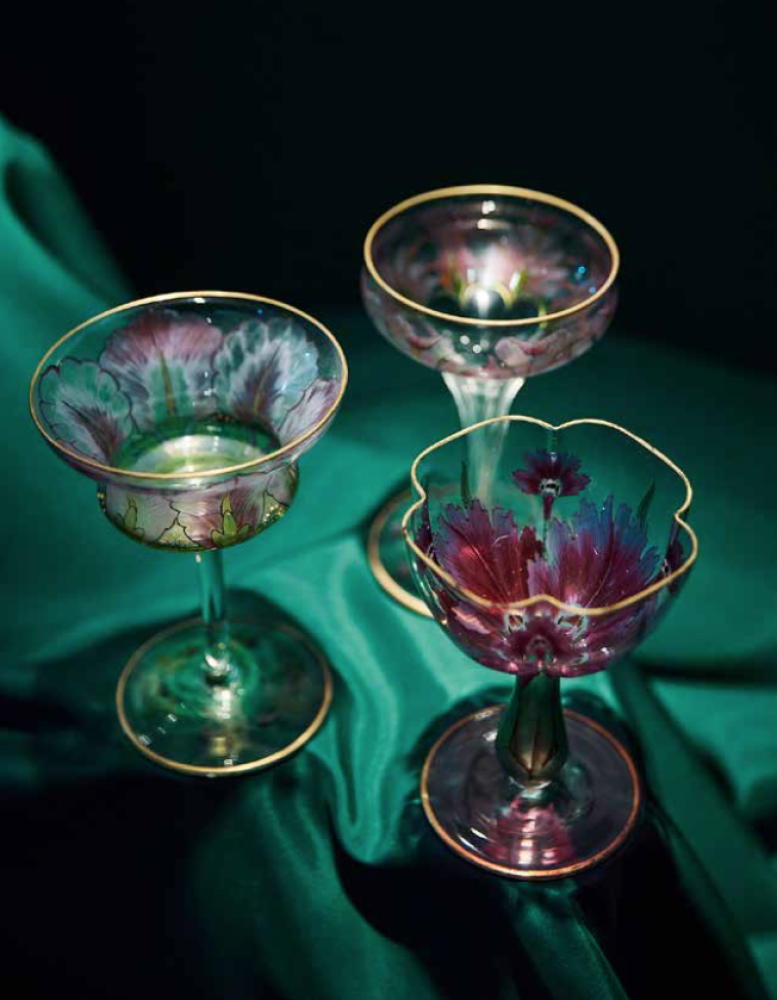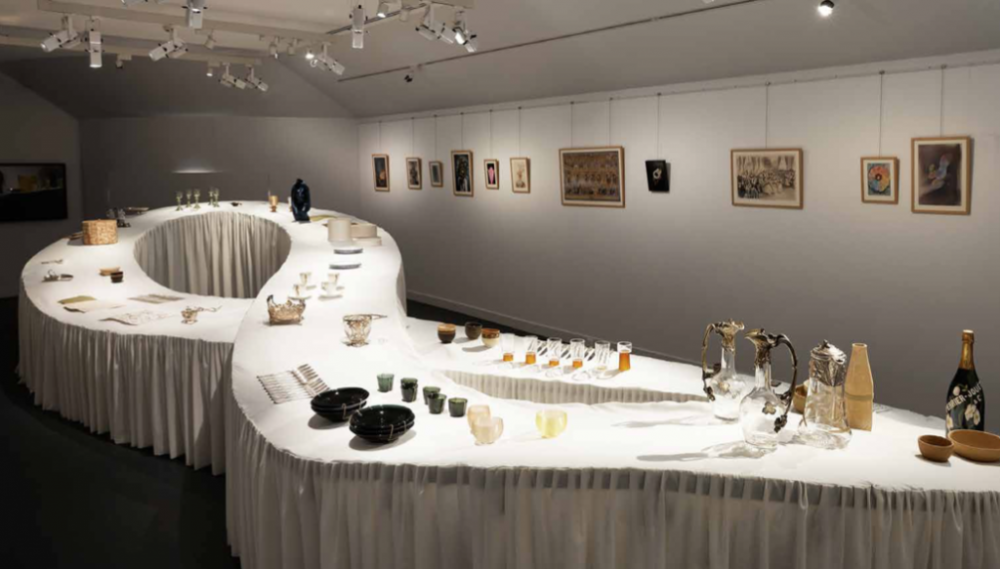Perrier-Jouët presents A Banquet of Wonders
Nov 20, 2023
French champagne house Perrier-Jouët has laid out a banquet for visitors to savour in its very first museum exhibition. Curator Benjamin Loyauté gives Dionne Bel the lowdown

Ever since the establishment of the Maison Perrier-Jouët in 1811 with the marriage of Pierre-Nicolas Perrier and Rose-Adélaïde Jouët, the fabled champagne house has been inextricably linked to art. The founders placed their joint passion for art and nature at the service of an exceptional champagne, and then fate brought together their grandson Octave Gallice and Émile Gallé, a renowned botanist and
pioneer of the Art Nouveau movement, who decorated one of the house’s magnums with a delicate sprinkling of white Japanese anemones in 1902. Referencing the floral character of the wine,
this embellishment adorning bottles of Perrier-Jouët Belle Époque has since become the brand’s trademark and is the very cornerstone of the inseparable link between the maison and Art Nouveau. Successive generations strengthened the connection with the artistic movement, assembling an assortment of objets d’art that represented the creative vitality of their time, and Perrier-Jouët now owns the largest private collection of French Art Nouveau in Europe.
Wishing to share its more than 200-year-old heritage with the widest possible audience, Perrier-Jouët decided to present its first-ever museum exhibition, A Banquet of Wonders, Delighting in the World, at the Museum of Champagne Wine and Regional Archaeology – inside the majestic Château Perrier built by Perrier and Jouët’s son, Charles Perrier – in Epernay, Champagne. On view through December 11, it is imagined as a stroll through the history of Perrier-Jouët’s own collection – some shown to the public for the first time – the museum’s collection, and loans from cultural institutions and private collectors. Pieces from the 17th century and Art Nouveau period rub shoulders with contemporary creations, forming a dialogue between artefacts from different eras that each have a relationship to nature and enchant our world. It’s all about celebrating the beauty of the moment, sharing, transmission and engagement.

“The Perrier-Jouët collection is designed like a banquet. Constantly evolving, it can be shared, enjoyed and celebrated,” explains Axelle de Buffévent, style director of Maison Perrier-Jouët. “The exhibition offers a banquet of wonders inviting us to sample the world: in other words, we are invited to celebrate the art of living, a generous way to engage with the world and open up to others.” Together with artist and design historian, Benjamin Loyauté, and Laure Ménétrier, director and curator of the Museum of Champagne Wine and Regional Archaeology, de Buffévent selected furniture, decorative objects and tableware reflecting the Art Nouveau spirit embraced by the house, which aims to bring beauty to everyday life.
Highlights include a highly-valued Hector Guimard bed, a dragonfly table and tulip-decorated wood marquetry coffer by Émile Gallé, colourful glazed ceramic plates depicting fish, coquillage and leaves in relief inspired by Bernard Palissy, a faience soup tureen in the form of a cabbage, Tomáš Libertíny’s honeycomb vase made of beeswax, whimsical cutlery by Geoffrey Mann and a fabulous array of champagne glasses. They are paired with 21st-century works commissioned by Perrier-Jouët from designers such as Bethan Laura Wood, Mischer’Traxler or Fernando Laposse.
But the magnum opus is the final banqueting room featuring a figure-eight table symbolising infinity and
the circulation of ideas. Conducive to visual feasting, it is laden with tableware representing the art of entertaining, including Franz Bergmann’s delightful radish-shaped patinated bronze bowl sculpted with a metamorphous nude figure. Like champagne, Perrier-Jouët’s banquet is a living, breathing entity that unites people to foster sharing, joy and conviviality.
What is the main idea behind A Banquet of Wonders, Delighting in the World?
There were several key principles that guided us through the whole process actually. Firstly, sharing and transmitting: the collection as both a material and symbolic heritage, and as a living legacy. The banquet as a place for sharing. Secondly, to assert and engage oneself: the collection as a means to converse, to manifest oneself to the world. Thirdly, to savour, celebrate and enchant the world: the collection with the banquet as a ceremonial object, a vector of sharing to celebrate the living and to marvel.
Also see: Il Divo’s Steven LaBrie talks music, touring and being the newest member
The title of the exhibition is inspired by a rare 18th- century volume, Le Tableau des Merveilles de l’Univers, which belonged to Henri Gallice, Pierre-Nicolas Perrier and Rose-Adélaïde Jouët’s grandson. Tell us more about this book and why you decided to name the exhibition after it.
The book tells us about a world made up of creations, oceans, the sun, animals. The word “wonder” has several meanings and I like the idea of an eighth wonder, which would be our way of seeing the world, of tasting it and of interacting with it to glimpse a world collaborating more and more with nature. The nature- culture relationship is very present in the exhibition. There is the natural wonderful and the cultural wonderful. The exhibition unveils contemporary design prowess. The talking objects (wonders of words) and engaged objects invented by Émile Gallé tell us about the world, and commensality as an object of discovery allows us to see the banquet as a place of words and commitment to make the world.

What is your definition of a banquet, and how is it representative of Perrier-Jouët’s desire to encourage sharing and the exchange of ideas?
It is the place of possibilities, of experiences, of fantasy, of sharing, of words, a land of endless exploration. It must also be a manifesto composed of authenticity and discernment, as it must summon the marvellous and its theatricality.
What criteria did you use to select the 200 pieces displayed in the exhibition?
The possible dialogue between works that are aesthetic, literary and even philosophical or sociological. The precision of the choices was made in relation to the chaptering of the exhibition, which I wanted as a book, a fable, a tale. A 17th- century ear work placed in relation to a 1900 biomorphic work reminds us that nothing is old because everything was created at a contemporary moment in history.
How did you come up with the idea of the sinuous dining table in the banquet room?
The idea came from a joint reflection with the scenographers on the dynamics of the banquet, on the principles of the movement, of the heritage which is transmitted, reflections also around the future of materials in culinary art and dining. The symbol of infinity because for me, the past was the present, and the future is taking shape in the present. It is also a form of freedom to make the table a space of reflection on the future by combining ancient and contemporary works oriented towards biodesign. It was also inspired by Surrealist dinners and balls, but, above all, by the fascinating table plans, which few know, by Joseph Gillier. They represent tables with tablecloths that form like gardens.





























